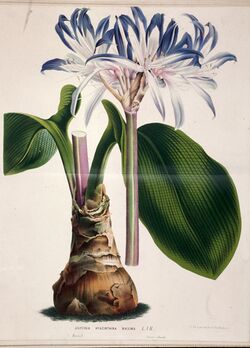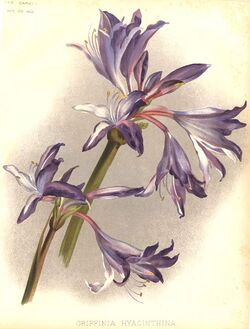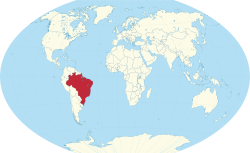Biology:Griffinia hyacinthina
| Griffinia hyacinthina | |
|---|---|

| |

| |
| Botanical illustrations of Griffinia hyacinthina | |
| Scientific classification | |
| Kingdom: | Plantae |
| Clade: | Tracheophytes |
| Clade: | Angiosperms |
| Clade: | Monocots |
| Order: | Asparagales |
| Family: | Amaryllidaceae |
| Subfamily: | Amaryllidoideae |
| Genus: | Griffinia |
| Species: | G. hyacinthina
|
| Binomial name | |
| Griffinia hyacinthina (Ker Gawl.) Ker Gawl.
| |

| |
| Griffinia hyacinthina is endemic to Brazil | |
| Synonyms[1] | |
| |
Griffinia hyacinthina is a bulbous species of flowering plant which is endemic to Brazil .[2][1]
Description
Bulbs and leaves
The tunicate bulbs of Griffinia hyacinthina can be up to 7.5 cm wide. They bear 5-7 leaves,[3] which are glabrous and petiolate.[4]
Flowers
The up to 60 cm long umbellate inflorescence, which exceeds the leaves in its height, bears up to seventeen blue-violet flowers lacking fragrance.[3] Within Griffinia subgenus Griffinia, it has the largest flowers.[2] Flowering occurs in the period of March through April. Up to five flowers may be open at the same time and they last for approximately one week.[3]
Reproduction
Generative reproduction
Flower and fruit formation in its natural habitat occurs in March to April. Infructescences with 1-7 fruits are formed.[4] Each pear-shaped fruit contains 1-3 seeds. Germination occurs within a period of 1-3 months and the seedlings reach maturity within 3-4 years.[4][3]
Vegetative reproduction
Vegetative reproduction occurs through bulbils, which form clusters around the mother plant.[4]
Taxonomy
This species was first described in 1817 as Amaryllis hyacinthina Ker Gawl. by John Bellenden Ker Gawler. Three years later he transferred it to Griffinia as Griffinia hyacinthina (Ker Gawl.) Ker Gawl.[1] It is the type species of its genus.[5]
Habitat
This species of Griffinia grows in a very specific habitat. It requires the warmth, deep shade and high humidity of the tropical rainforest where the floor is covered with large quantities of organic matter. Like related species, G. hyacinthina is endemic to Brazil . It is native to the south-eastern part of the country, specifically the Atlantic Forest.
Conservation
This species is endangered. It is threatened by extinction, due to habitat destruction.[4]
Cultivation
It should be cultivated in well draining soils with a high proportion of organic material.[4]
References
- ↑ 1.0 1.1 1.2 "Griffinia hyacinthina (Ker Gawl.) Ker Gawl." (in en). Royal Botanic Gardens, Kew. http://www.plantsoftheworldonline.org/taxon/64573-1. Retrieved 2 June 2023.
- ↑ 2.0 2.1 Meerow, A. W., Preuss, K. D., Fernando, A., & Tombolato, C. (2000, August). "Griffinia (Amaryllidaceae), a critically endangered Brazilian geophyte with horticultural potential." In VIII International Symposium on Flowerbulbs 570 (pp. 57-64).
- ↑ 3.0 3.1 3.2 3.3 de Aguiar Silveira, R. B. (1995). "Griffinia hyacinthina (Ker-Gaw.) Ker-Gaw., Amaryllidaceae da Mata Atlântica a ser preservada." Ornamental Horticulture, 1(1), 1-1.
- ↑ 4.0 4.1 4.2 4.3 4.4 4.5 Kirizawa, M., LopesI, E. A., IveiraI, R. B. D. A. S., Tavares, A. R., & Kanashiro, S. "Griffinia hyacinthina (Ker Gawl.) Ker Gawl., Amaryllidaceae da Mata Atlântica, endêmica e em perigo de extinção: estudos morfológico e horticultural."
- ↑ Griffinia | International Plant Names Index. (n.d.). Retrieved June 27, 2023, from https://www.ipni.org/n/330432-2
Wikidata ☰ Q15514560 entry
 |

